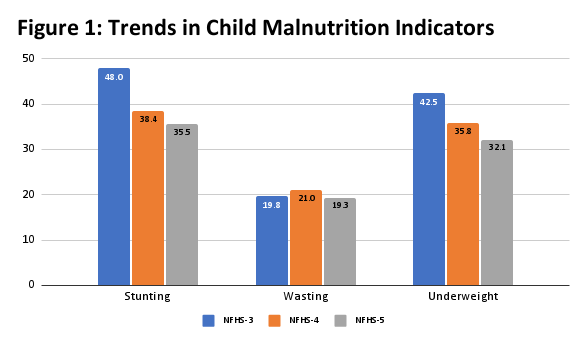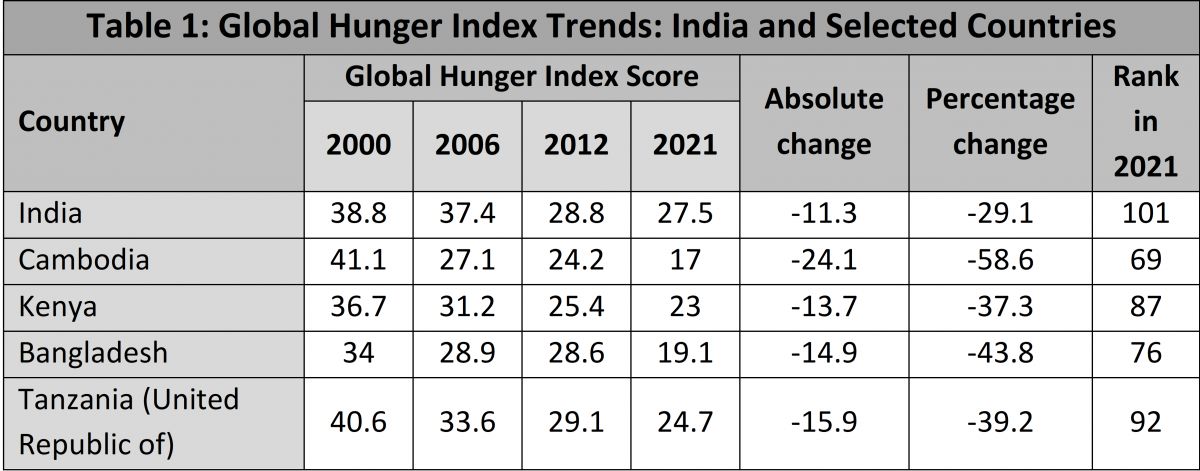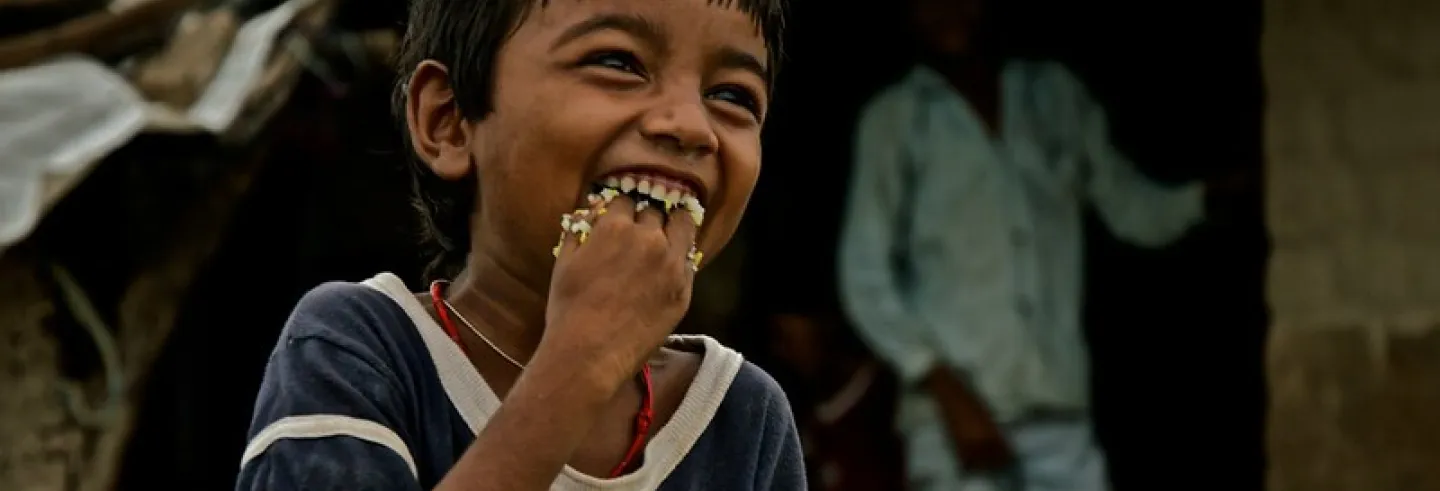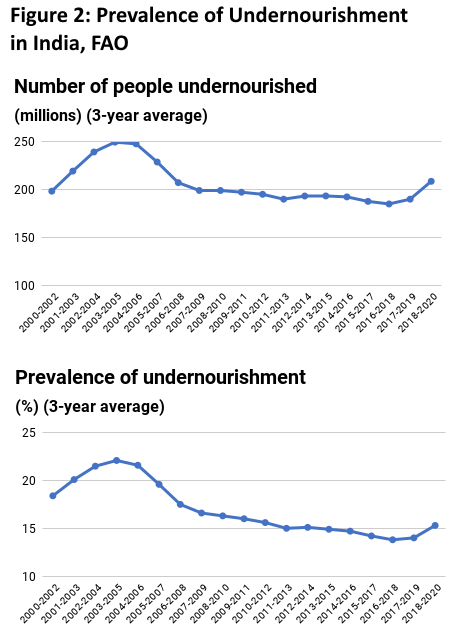Distress and food insecurity persisted across the country in late 2021, after the second wave of Covid-19 had subsided and before Omicron had spread. This is the message from the Hunger Watch-II report of the Right to Food campaign, based on surveys conducted across December 2021 and January 2022.
While comprehensive data on nutrition outcomes after Covid-19 is not yet available, there are a number of indications showing that the pandemic in India has severely impacted food security among the poor and marginalised sections of society.
The Covid-19 crisis is expected to aggravate the problem of malnutrition across the world. It has been estimated that by 2022, pandemic-induced disruptions in nutrition in 118 low- and middle-income countries (LMICs) will result in an additional 9.3 million wasted children (low weight for height) and 2.6 million stunted children (low height for age).
[G]oing by the national data at face value, there seems to be only minimal improvement (and even worsening in some cases) in most undernutrition indicators.
In absolute numbers, India contributes the most to the global burden of childhood stunting. Therefore, the findings on the global impact of the pandemic have serious implications for our children. Moreover, India’s nutrition outcomes had been poor over a long period, even before the Covid-19 crisis.
We need to look at trends in malnutrition in India in the recent past, along with the impact of Covid-19 and the ongoing economic crisis. It is important for us to understand what is going on, so that immediate measures can be taken to mitigate the effects of the pandemic on malnutrition.
India: Trends in malnutrition
The most recent data on malnutrition in India is from the National Family Health Survey, 2019–20 (NFHS-5). Phase I of this survey was conducted before the pandemic started (end 2019 and early 2020), while Phase II was conducted after the national lockdown, in the second half of 2020.
The NFHS-5 data show that there is some improvement in childhood stunting, albeit slow, and an increase in anaemia prevalence and childhood wasting. The data also reveals that most of the states covered in the first phase of the survey showed an increase or stagnation in the extent of stunting, while all the states covered in the second phase show an improvement. 1 Both phases included states from different regions and at different levels of economic development. There is no easy explanation for this variation and we will probably have to wait for the detailed report and the unit data to understand these results better. However, going by the national data at face value, there seems to be only minimal improvement in most indicators of nutrition (and even worsening in some cases).
The available data suggests that diets in India are heavily cereal based, with very little diversity and inadequate consumption of nutritious foods...
While stunting reduced by 10 percentage points (pp) during the period 2005–6 to 2015–16 (1pp per year); between 2015–16 and 2019–20 the reduction was 3 percentage points (0.7pp per year). In contrast, the goals set under the National Nutrition Mission in 2017 aimed at a reduction in stunting of 2pp per year. NFHS-5 also shows an increase in anaemia prevalence among women and children. Sixty seven per cent of children are anaemic according to NFHS-5, compared with 59% for NFHS-4. The corresponding figures for non-pregnant women are 52% and 50%. NFHS-5 further shows that there is some improvement in the extent of exclusive breastfeeding and infant and young child feeding practices, although this is very slow. (Nguyen et.al, 2022).

For a complete understanding of malnutrition trends and its determinants, we need to look into a whole set of complex factors. However, food consumption and the quality of diets are immediate and important determinants of malnutrition. Unfortunately, such data has always been inadequate in India. While the regular consumption expenditure surveys of the National Statistical Office (NSO) were useful, the decision to scrap the 2017–18 survey has meant that the last data with us is for 2011–12, a decade old.
The available data suggests that diets in India are heavily cereal based, with very little diversity and inadequate consumption of nutritious foods such as pulses, vegetables, fruits, milk, eggs, and meat (Prasad and Sinha, 2019).
Comparative performance: Global Hunger Index
India has been performing poorly in global rankings of hunger. It ranks 101st out of 116 countries on the Global Hunger Index (GHI) 2021. While the GHI ranks across the years are not comparable because of methodological issues and changes in the list of countries included each year, the GHI scores can be compared over time and across countries. Since 2000, India has been ranking below all other South Asian countries except Afghanistan. Not only have these countries been performing better consistently, but their improvement has also been faster over the last 20 years.
The Global Hunger Report 2021 gives comparable GHI scores for four separate years between 2000 and 2021. 2 The GHI score measures the severity of hunger. Therefore the higher the score the more severe the level of hunger. The scores are then categorised into groups ranging from ‘Low’ to ‘Extremely Alarming’. Table 1 compares the GHI for India with four countries: all ranking better than India currently but with GHI scores close to or worse than India’s in 2000. This shows the relatively slow improvement in India. Cambodia which in 2000 had a GHI of 41.1, higher than India’s 38.8, managed by 2021 to reduce its score to 17, while India could lower it to only 27.5. During this period Cambodia moved from the ‘Alarming’ to the ‘Moderate’ category, while India moved from ‘Alarming’ to ‘Serious’.

When the GHI was released a few months back, India put out an official press note claiming that the index used flawed methodology and was not a true reflection of hunger in the country. The main official objections were two-fold. First, that the GHI was based on a phone survey conducted on a small sample and therefore not representative of the true picture in the country. This was not true. The authors of the report clarified that anyone who read the report could see that the data used were not from any phone survey, but, rather, based on official indicators from government or UN sources.
The second objection, which representatives of the NITI Ayog and others have written about, is that while the GHI is called a ‘hunger’ index, it actually measures malnutrition. This is nothing but engaging in semantics while trying to distract attention from the more substantial issues. As explained by the Global Hunger Report, “Hunger is usually understood to refer to the distress associated with a lack of sufficient calories. The Food and Agriculture Organization of the United Nations (FAO) defines food deprivation, or undernourishment, as the consumption of too few calories to provide the minimum amount of dietary energy that each individual requires to live a healthy and productive life, given that person’s sex, age, stature, and physical activity level.” The GHI includes measures of population undernourishment, childhood stunting, childhood wasting and child mortality and tries to capture it in a broader sense of food insecurity and malnutrition.
Hunger in India
Measuring hunger has been deeply controversial in India and globally, but the most common way in which it is done is by looking at adequacy of food consumption in calorie terms. Some analysis based on the data from the 2017–18 NSS consumption expenditure survey, as available in a leaked report (and analysed in the The India Forum), showed that mean consumption expenditure, as well as the mean consumption expenditure on food, declined between 2011–12 and 2017–18. These declines in average per capita consumption expenditures on food most likely reflect an increase in hunger amongst the poor (Subramanian, 2019). A decline in real food consumption expenditure also indicates an increase in poverty.
While one waits for the next round of the NSS consumption expenditure data to be released, we need to look at other indicators, which tell us that the situation of food and nutrition security in India seems to have worsened (at least in some pockets) post-2015.
The FAO’s Prevalence of Undernourishment (PoU) indicator is used to monitor hunger at the global and regional level. The PoU is based on country data on food availability, food consumption, and energy needs, and it estimates the adequacy of a population’s dietary energy intake. The PoU is based on data from government sources, including indicators of production, affordability, availability and consumption, some of which is available on an annual basis 3 Given the absence of poverty and consumption expenditure data in India post 2011 the estimates of the FAO make some assumptions on trends to arrive at the data for recent years assuming that the same trend as the earlier period continues. . (It is also one of the three indicators used in the GHI.)
As can be seen in Figure 2, while the undernourishment in India showed a secular decline from around 2005 onwards, the last few years have shown a reversal of this trend. Both as a proportion and in absolute numbers, there has been an increase in the prevalence of undernutrition after 2016. The prevalence of undernutrition, taken as a three-year moving average, was 13.8% for 2016–18, going up to 14% in 2017–19, and 15.3% in 2018–20. This data does not take into account the pandemic years, which based on all indications can be expected to have been worse.
Pandemic and hunger
Various surveys have shown that after the national lockdown in 2020, there was a decline in incomes of the poor and a greater informalisation of the economy. Over 230 million people are estimated to have fallen below the minimum-wage poverty line as a result of the pandemic (APU, 2021). Several field surveys showed that following the national lockdown, levels of food insecurity were also high.
By reviewing the results of 76 household surveys complied by CSE-APU, Drèze and Somanchi (2021) found that the national lockdown was associated with a tremendous food crisis, with a particularly sharp decline in consumption of nutritious items. Further, while there was some recovery once the lockdown ended in 2020, employment, income, and nutrition levels at end 2020 remained much below pre-pandemic levels. Hunger Watch I, conducted in October-November 2020, found that over two-thirds of the respondents reported a decline in nutritional quantity and deterioration in nutritional quality compared with their pre-pandemic consumption. In the month preceding the survey, almost 30% of the respondents experienced going to bed without eating.
The Hunger Watch I [reports of October-November 2020]…found that over two-thirds of the respondents reported a decline in nutritional quantity and deterioration in nutritional quality...
While these surveys covered the period towards the end of 2020, the second wave of the pandemic during April–May 2021 was even more devastating. Although there was no national lockdown, most places had localised curfews and a shutdown of economic activity. The severity of the Covid-19 infections was higher, with cases spreading to rural areas.
The impact was seen once again on employment and livelihoods, accompanied by catastrophic health expenditure for many. There are not many reports yet of the status of food security after the second wave. Hunger Watch II, covering about 7000 respondents across 14 states, reports continued distress and food insecurity. Over 40% of the households interviewed reported a decline in nutritional quantity and quality compared with pre-pandemic levels. Forty-five per cent of the households had some outstanding debt, and 67% said that they could not afford cooking gas in the month preceding the survey.
Consumption of nutrient-rich foods was poor. More than half of the households consumed eggs, flesh foods, or fruits fewer than two or three times a month. In the case of pulses and green leafy vegetables, more than a quarter of the households consumed these foods fewer than two or three times a month. The survey also included the Global Food Insecurity Experience Scale (GFIES), based on which it found that about 80% of the sample households reported some form of food insecurity in the month preceding the survey, and 25% reported severe food insecurity.
The Hunger Watch reports focussed on capturing the experiences of those belonging to poor and marginalised communities. However, triangulating this information with the other data sources presented here, it is reasonable to conclude that its findings are not exceptional and reflect the conditions of food insecurity amongst a large section of India’s population.
Distress times: Need for public support
The current extent of food insecurity and malnutrition in India is related to the overall conditions of economic distress, which had set in even before the pandemic. The GDP growth rate for 2019–20 was less than 4%, slowing down sharply from more than 8% in 2016–17. The year 2020–21 saw a negative growth of 6.6%, followed by some recovery in 2021–22. The initial official estimates show that per capita incomes in 2021–22 remain lower than what they were in 2019–20.
The years since 2015 have also witnessed stagnation in rural real wages and high unemployment rates, along with increasing inequality (ICE 360 data, as reported in Azad and Chakraborty, 2022). A significant increase in rural and urban poverty between 2011–12 and 2019–20 has also been reported, based on an analysis of consumption expenditure data from the employment surveys of the NSS (Mehrotra and Parida, 2021). Analysts have suggested that the economic slowdown is partly because of the 2016 demonetisation and 2017 introduction of GST and their uneven impact on the informal sector, followed by the pandemic-induced distress. As a result, we see depressed incomes and high unemployment, which impact hunger and food insecurity.
Detailed research establishing the links between the economic slowdown, the weakening of welfare programmes, and their impact on malnutrition will need more data.
In this context, the various social protection schemes of the government could play a very significant role. Field surveys, including Hunger Watch, have shown that the additional free food grains distributed during the pandemic under the Pradhan Mantri Garib Kalyan Anna Yojana (PMGKAY) reached most eligible beneficiaries and contributed to providing some cereal security. Many, however, have been excluded because they do not have ration cards.
Other direct nutritional interventions, such as the Integrated Child Development Services (ICDS) and school meals, can also be useful. But with school and anganwadi closures, these schemes have been disrupted. Budgetary allocations for them schemes have also been declining since 2014–15, in real terms (see the calculation put out by the group ‘Road Scholarz’ on Twitter). The Union Budget for 2022-23 reduced allocations for food and nutrition-related schemes such as the Public Distribution System (PDS), mid-day meals, anganwadis, and social security pensions.
Detailed research establishing the links between the economic slowdown, the weakening of welfare programmes, and their impact on malnutrition will need more data. And take time to analyse. But in the meanwhile it is unacceptable that another generation of children will remain malnourished.
Views presented here are personal.











Poor sanitation in TN